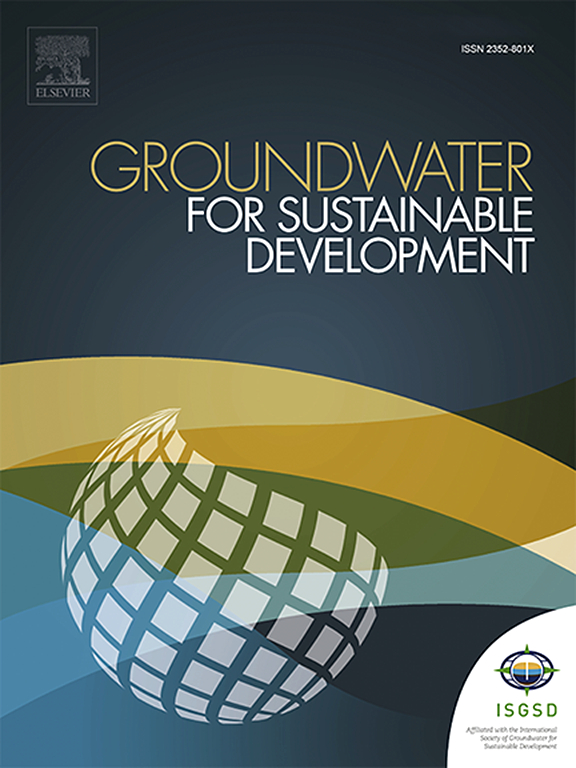Would mixed physical barriers be able to desalinate coastal aquifers from seawater intrusion under pumping conditions?
IF 4.9
Q2 ENGINEERING, ENVIRONMENTAL
引用次数: 0
Abstract
This study used the SEAWAT model to investigate the potential of using mixed physical barriers (MPB) to control SWI under pumping conditions in typical homogenous and layered heterogeneous coastal aquifers. The numerical models were based on controlled two-dimensional (2D) laboratory tests and field studies in the Biscayne aquifer, which is situated in the Cutler Ridge region close to Deering Estate, Florida, USA. The modelling results revealed critical insights into SWI behaviour under pumping conditions. Specifically, it was observed that the intrusion wedge extended significantly further inland in layered heterogeneous aquifers and homogeneous aquifers compared with the base case without pumping. Results showed that coastal aquifers with bottom low-hydraulic conductivity have smaller SWI compared with top and middle-layered aquifers. The SWI repulsion reached 27% by installing the MPB, while the groundwater salinity increased to 3%, 38% and 121% by increasing the abstraction well rates by 10 m3/day, 15 m3/day and 20 m3/day, compared with no pumping after using the MPB. The current study results are very interesting for coastal aquifer management and require economic study to ensure the feasibility of using this method.

混合物理屏障是否能够在抽水条件下淡化海水入侵的沿海含水层?
本研究使用SEAWAT模型研究了在典型均质和层状非均质沿海含水层的抽水条件下,使用混合物理屏障(MPB)控制SWI的潜力。数值模型是基于受控二维(2D)实验室测试和比斯坎含水层的实地研究,比斯坎含水层位于美国佛罗里达州迪尔林庄园附近的卡特勒岭地区。建模结果揭示了泵送条件下SWI行为的关键信息。具体来说,与不抽水的基本情况相比,在层状非均质含水层和均质含水层中,侵入楔向内陆延伸得更远。结果表明:底层低导水率的沿海含水层SWI比上层和中层含水层小;安装MPB后,SWI排斥力达到27%,而与使用MPB后不抽水相比,通过将抽水量分别提高10 m3/天、15 m3/天和20 m3/天,地下水矿化度分别提高到3%、38%和121%。目前的研究结果对沿海含水层管理非常有意义,需要进行经济研究以确保该方法的可行性。
本文章由计算机程序翻译,如有差异,请以英文原文为准。
求助全文
约1分钟内获得全文
求助全文
来源期刊

Groundwater for Sustainable Development
Social Sciences-Geography, Planning and Development
CiteScore
11.50
自引率
10.20%
发文量
152
期刊介绍:
Groundwater for Sustainable Development is directed to different stakeholders and professionals, including government and non-governmental organizations, international funding agencies, universities, public water institutions, public health and other public/private sector professionals, and other relevant institutions. It is aimed at professionals, academics and students in the fields of disciplines such as: groundwater and its connection to surface hydrology and environment, soil sciences, engineering, ecology, microbiology, atmospheric sciences, analytical chemistry, hydro-engineering, water technology, environmental ethics, economics, public health, policy, as well as social sciences, legal disciplines, or any other area connected with water issues. The objectives of this journal are to facilitate: • The improvement of effective and sustainable management of water resources across the globe. • The improvement of human access to groundwater resources in adequate quantity and good quality. • The meeting of the increasing demand for drinking and irrigation water needed for food security to contribute to a social and economically sound human development. • The creation of a global inter- and multidisciplinary platform and forum to improve our understanding of groundwater resources and to advocate their effective and sustainable management and protection against contamination. • Interdisciplinary information exchange and to stimulate scientific research in the fields of groundwater related sciences and social and health sciences required to achieve the United Nations Millennium Development Goals for sustainable development.
 求助内容:
求助内容: 应助结果提醒方式:
应助结果提醒方式:


